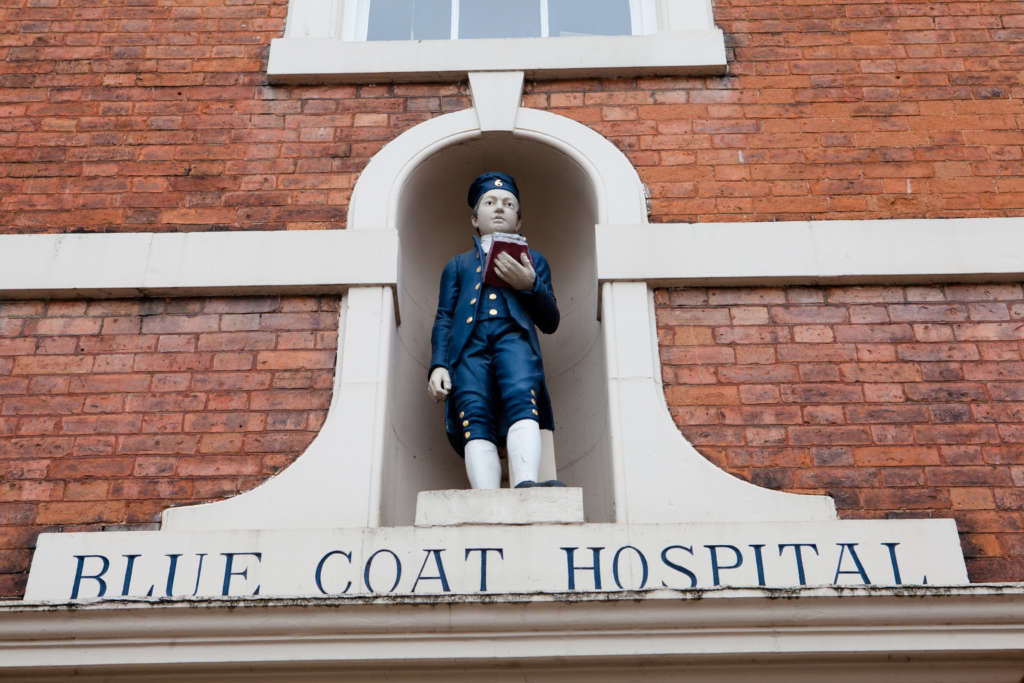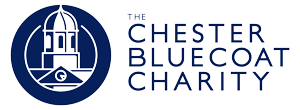History of the Bluecoat building
The Bluecoat site has had various uses since the founding of a hospital on the land in 1190.
Chapter one: 1190 – 1717: A hospital
The Hospital of St John the Baptist was founded in 1190, on the site of the current Bluecoat building. This was an ecclesiastical foundation, with a priory housing brethren and lay servants living under religious rule. In 1241, permission was given for a chapel to be built.
The hospital had a chequered history with several phases of neglect and impoverishment. However, it is known that around the middle of the 14th century there were 13 beds kept ready for the city’s poor. Each inmate was to receive a daily allowance of a loaf of bread, a dish of pottage, half a gallon of ale and a piece of meat or fish.
The almshouses behind the Bluecoat – the direct successors to this hospital – still provide accommodation to this day.
In 1644 the hospital was demolished. Its stone buildings, chapel and the surrounding wall were pulled down, so they couldn’t provide cover for the Parliamentary forces who were besieging the city. Nothing remains of this original hospital building.
Chapter two: 1717 – 1949: The Bluecoat School
In 1717, the Chester Corporation gave permission for the Bluecoat Hospital School to be built. This school for poor boys was one of the first charity schools outside London. It was built on the site of the original hospital, on condition a new chapel was also built there.
The school was originally an L-shaped building, with its main wing on Upper Northgate Street. The south wing contained a chapel and the main wing a schoolroom and dormitories. A north wing was added in 1733.
By 1762, the Chester Corporation gave up the ownership of the land – on which the school stood – to the Bluecoat Trustees. The St John’s Hospital Trust kept ownership of the Bluecoat’s chapel, plus land at the back of the school (where the almshouses were built).
In 1854, the central section was enlarged by the building of a new frontage closer to Northgate Street. The clock (housed in the bell tower) was added the following year. The Bluecoat School underwent various stages of development. From 1755 to 1761 it shared the Bluecoat with the Chester Infirmary, which treated patients in the first-floor rooms.
Under a scheme in 1787, pupil numbers were reduced from 40 to 25, with boys only being admitted as boarders at the age of 11 for two years.
Meanwhile, a new day school – the Green Cap School – was created, catering for up to 60 boys aged nine and above, and this also met in the Bluecoat. In 1818 the Consolidated School for Girls (derived from various Sunday schools and working schools) opened in the building.
The original Bluecoat School, along with the Green Cap School, continued in the same premises throughout the 19th century. Kelly’s Directory for 1896 described them as having, at that time, 36 and 64 boys respectively, with orphans and the sons of widows being given preference for admission to the Bluecoat school.
The Green Cap School eventually closed in 1901 and the Bluecoat School in 1949.
Chapter three: 1949 – 2015: Various uses
Since then, the Bluecoat has been used for offices and shops, an adult education centre and youth club, a welfare and job advice centre and as county council offices. In 1996 it became home to the University of Chester’s history department.
Chapter four: 2015 – present: A charity hub
The Bluecoat later lay empty for several years until Chester Municipal Charities (now renamed The Chester Bluecoat Charity) reopened the premises in 2015, as a centre for charities and voluntary organisations with the provision of meeting rooms for all, following a £1.3 million revamp.
The Bluecoat Boy

A Bluecoat Boy statue was placed at the front of building in 1854, after an appeal raised £25 to meet the costs. The statue’s model was John Coppack, a pupil at the Bluecoat School from February 1853 to February 1854. Born in August 1840, he was the son of a shoemaker in Northgate Street, but his mother had died by the time he enrolled at the school. John went on to work as a coal merchant and later as a corresponding clerk for the Shropshire Union Canal Company. He married in 1859, and the first of his 14 children was born in 1861, the same year he became a Freeman of the City of Chester. He died in 1898 aged 57.
The Bells

The Bluecoat has two historic bells – the Galeka bell and the Bell Tower bell.
The Galeka bell has an interesting history as it was rescued from a First World War hospital ship, click on the left hand image to read more!
The bell in the bell tower (in the centre of the Bluecoat roof) was made in 1716 and has been in situ since 1717 and peels on the hour every waking hour!

